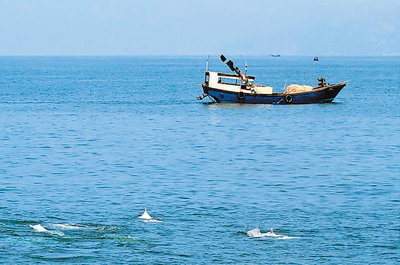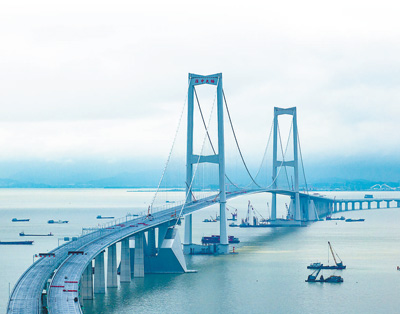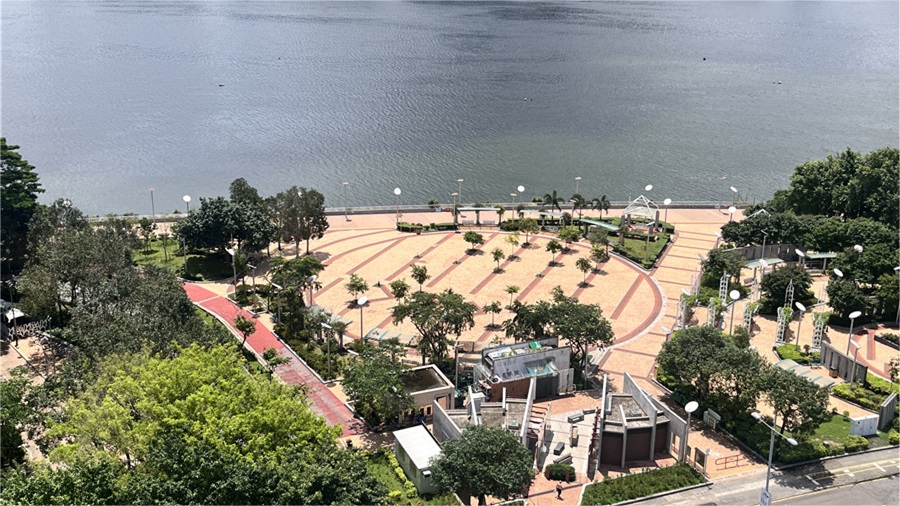Workers safeguard Chinese white dolphin habitat during Shenzhen-Zhongshan link construction

Chinese white dolphins are seen in the construction area of the Shenzhen-Zhongshan link in south China's Guangdong Province. (Photo/Lin Wenqi)
"Look, Chinese white dolphins!"
Workers at the construction site of the west artificial island of the Shenzhen-Zhongshan link in south China's Guangdong Province were thrilled to see a group of Chinese white dolphins in the Lingdingyang waters of the Pearl River Estuary. The dolphins dived in and out the water, creating a captivating spectacle alongside the Shenzhen-Zhongshan link.
The design of the Shenzhen-Zhongshan link incorporated ecological protection from its inception, integrating it into construction, shipping, and environmental monitoring.
Through technological, process, and management innovation, the project aims to better protect Chinese white dolphins, which are under first-class state protection in China, according to Xu Guoping, chief tunnel designer of the Shenzhen-Zhongshan link from China Communications Construction Company (CCCC) Highway Consultants Co., Ltd.
The Pearl River Estuary Chinese White Dolphin National Nature Reserve, covering an area of around 460 square kilometers, is home to a significant population of Chinese white dolphins.
The Shenzhen-Zhongshan link is a cross-sea cluster project that includes bridges, artificial islands, tunnels, and submerged connection. The massive engineering project presents significant challenges for the conservation of Chinese white dolphins.
From the air, the west artificial island of the Shenzhen-Zhongshan link resembles a bird in flight.
"Constructing an island of approximately 137,000 square meters, equivalent to 19 standard football fields, on the vast sea would disrupt the Chinese white dolphins' habitat if traditional construction methods were used," said Liu Haobin, deputy general manager of the Shenzhen-Zhongshan link project from CCCC First Harbor Engineering Co. Ltd.

Photo shows the Shenzhen-Zhongshan Bridge. (Photo/Shen Zhong)
The construction team independently developed a device that helped drive 57 giant steel cylinders into the seabed rock layers in just four and a half months, setting a new world record for rapid island construction. This achievement also helped minimize the impact on the marine environment and Chinese white dolphins.
The key project, a 5,035-meter-long underwater immersed tube tunnel, involved connecting 32 sections of immersed tubes and a final joint. Transporting the immersed tubes from the factory to the installation area required navigating a 50-kilometer-long sea route with 7 channel changes.
According to Ning Jinjin, deputy general manager of the project from CCCC First Harbor Engineering Co. Ltd., the factory that produces immersed tubes for the construction of the tunnel was upgraded and repurposed from another factory, which had originally been utilized for the construction of the Hong Kong-Zhuhai-Macao Bridge.
This decision enabled the project to significantly reduce offshore construction activities and minimize any potential negative effects on the Pearl River Estuary Chinese White Dolphin National Nature Reserve.
Transporting the immersed tubes quickly to their designated positions presented a challenge. The construction team proposed a creative solution - building a ship for both tube transportation and installation.
"This ship can reduce dredging by over 10 million cubic meters, and emissions by around 1 million cubic meters, effectively safeguarding the marine environment where the dolphins reside," said Ning.
To further protect the dolphins, the construction team developed a patented anti-pollution system for cement mixing vessels. This system creates two pollution barriers, preventing the sewage generated from piling from entering the sea and polluting the dolphins' habitat.
In addition to technological advancements, the construction team developed a Chinese white dolphin protection management manual. This manual assigns direct responsibility for dolphin protection to the captain of each construction vessel and appoints dedicated dolphin observers to monitor their activities day and night.
To minimize the impact on the marine environment, the construction team implements green practices for handling domestic and production waste.
The project has implemented measures to minimize dust generation during sand and gravel transport. This involves the use of protective clothing for vehicles, ensuring that tank trucks are cleaned and the liquid on them is absorbed by absorbent pads when entering and leaving the mixing station. Additionally, dust collectors have been installed on top of storage tanks for powdered materials, according to Liao Wenlong from CCCC Second Harbor Engineering Co., Ltd.
Photos
Related Stories
- Pic story: deep bond between French scientist and Chinese white dolphins
- Chinese white dolphins spotted in Leizhou Bay
- Casual encounter with Chinese white dolphins by China Coast Guard
- Extremely rare Chinese white dolphins seen in Xiamen
- Chinese white dolphins seen at sea in south China
- Chinese coast guard encounters school of dolphins
- Chinese white dolphins appear in waters of SE China's Xiamen
- Dolphins swim freely in the East China Sea
- Dolphins frolic near Ningbo
- Dolphins spotted in Xisha waters
Copyright © 2024 People's Daily Online. All Rights Reserved.









